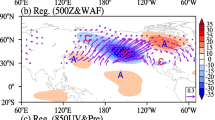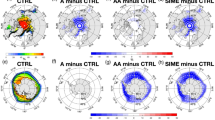Abstract
Based on NCEP/NCAR (National Centers for Environmental Prediction/National Center for Atmospheric Research) reanalysis data from 1979 to 2010, the impacts of two types of El Niño on atmospheric circulation in the Southern Hemisphere (SH) are analyzed. It is shown that, when a warming event occurs in the equatorial eastern Pacific (EP El Niño), there is a negative sea level pressure (SLP) anomaly in the eastern Pacific and a positive one in the western Pacific. Besides, there exists a negative anomaly between 40°S and 60°S and a positive anomaly to the south of 60°S. When a warming event in the central Pacific (CP El Niño) occurs, there appears a negative SLP anomaly in the central Pacific and a positive SLP anomaly in the eastern and western Pacific, but the SLP anomalies are not so evident in the SH extratropics. In particular, the Pacific-South America (PSA) pattern induced by the CP El Niño is located more northwestward, with a weaker anomaly compared with the EP El Niño. This difference is directly related with the different position of heating centers associated with the two types of El Niño events. Because the SST anomaly associated with CP El Niño is located more westward than that associated with EP El Niño, the related heating center tends to move westward and the response of SH atmospheric circulation to the tropical heating changes accordingly, thus exciting a different position of the PSA pattern. It is also noted that the local meridional cell plays a role in the SH high latitudes during EP El Niño. The anomalous ascending motion due to the enhancement of convection over the eastern Pacific leads to an enhancement of the local Hadley cell and the meridional cell in the middle and high latitudes, which in turn induces an anomalous descending motion and the related positive anomaly of geopotential height over the Amundsen-Bellingshausen Sea.
Similar content being viewed by others
References
Ashok, K., and T. Yamagata, 2009: The El Niño with a difference. Nature, 461, 481–484.
Ashok, K., S. Behera, S. A. Rao, H. Weng, and T. Yamagata, 2007: El Niño Modoki and its teleconnection. J. Geophys. Res., 112, C11, doi: 10.1029/2006JC003798.
Cai, W., and T. Cowan, 2009: La Niña Modoki impacts Australia autumn rainfall variability. Geophys. Res. Lett., 36, L12805, doi: 10.1029/2009GL037885.
Connolley, W. M., 1997: Variability in annual mean circulation in southern high latitudes. Climate Dyn., 13, 745–756.
Feng, J., and J. Li, 2011: Influence of El Niño Modoki on spring rainfall over south China. J. Geophys. Res., 116, D13102, doi: 10.1029/2010JD015160.
Feng, J., L. Wang, W. Chen, S. K. Fong, and K. C. Leong, 2010: Different impacts of two types of Pacific Ocean warming on southeast Asian rainfall during boreal winter. J. Geophys. Res., 115, D24112, doi: 10.1029/2010JD014761.
Feng, J., W. Chen, C.-Y. Tam, and W. Zhou, 2011: Different impacts of El Niño and El Niño Modoki on China rainfall in the decaying phases. Int. J. Climatol., 31, 2091–2101.
Garreaud, R. D., and D. S. Battisti, 1999: Interannual (ENSO) and interdecadal (ENSO-like) variability in the Southern Hemisphere tropospheric circulation. J. Climate, 12, 2113–2123.
Gill, A. E., 1980: Some simple solutions for heat-induced tropical circulation. Quart. J. Roy. Meteor. Soc., 106, 447–462.
Hoskins, B. J., and D. J. Karoly, 1981: The steady linear response of a spherical atmosphere to thermal and orographic forcing. J. Atmos. Sci., 38, 1179–1196.
Huffman, G. J., and Coauthors, 1997: The Global Precipitation Climatology Project (GPCP) combined precipitation dataset. Bull. Amer. Meteor. Soc., 78, 5–20.
Kalnay, E. M., and Coauthors, 1996: The NCEP/NCAR40 year reanalysis project. Bull. Amer. Meteor. Soc., 77, 437–471.
Kao, H. Y., and J. Y. Yu, 2009: Contrasting eastern-Pacific and central-Pacific types of ENSO. J. Climate, 22, 615–632.
Karoly, D. J., 1989: Southern Hemisphere circulation features associated with El Niño-Southern Oscillation events. J. Climate, 2, 1239–1252.
Kidson, J. W., 1999: Principal modes of Southern Hemisphere low-frequency variability obtained from NCEP-NCAR reanalyses. J. Climate, 12, 2808–2830.
Kiladis, G. N., and K. C. Mo, 1998: Interannual and intraseasonal variability in the Southern Hemisphere. Chapter 8, Meteorology of the Southern Hemisphere, Karoly and Vincent, Eds., American Meteorological Society Monograph, No. 27, Boston, Massachussetts, 307–336.
Kug, J., F. Jin, and S. An, 2009: Two types of El Niño events: Cold tongue El Niño and warm pool El Niño. J. Climate, 22, 1499–1515.
Kumar, K., B. Rajagopalan, M. Hoerling, G. Bates, and M. Cane, 2006: Unraveling the mystery of Indian monsoon failure during El Niño. Science, 314, 115–119.
Lee, T., and M. J. McPhaden, 2010: Increasing intensity of El Niño in the central-equatorial Pacific. Geophys. Res. Lett., 37, L14603, doi: 10.1029/2010GL04407.
Liebmann, B., and C. A. Smith, 1996: Description of a complete (interpolated) outgoing longwave radiation dataset. Bull. Amer. Meteor. Soc., 77, 1275–1277.
Liu, C. Z., and F. Xue, 2010: The relationship between the canonical ENSO and the phase transition of the Antarctic oscillation at the quasi-quadrennial timescale. Acta Oceanologica Sinica, 29, 28–37.
Matsuno, T., 1966: Quasi-geotropic motions in the equatorial area. J. Meteor. Soc. Japan, 44, 25–42.
Mo, K. C., and W. Higgins, 1998: The Pacific-South American modes and tropical convection during the Southern Hemisphere winter. Mon. Wea. Rev., 126, 1581–1596.
Nigam, S., 1994: The dynamical basis for the Asian summer monsoon rainfall-El Niño relationship. J. Climate, 7, 1750–1771.
Rayner, N. A., D. E. Parker, C. K. Folland, L. V. Alexander, D. P. Rowell, E. C. Kent, and A. Kaplan, 2003: Global analyses of sea surface temperature, sea ice, and night marine air temperature since the late nineteenth century. J. Geophys. Res., 108, 4407, doi: 10.1029/2002JD002670.
Renwick, J. A., 1998: ENSO-related variability in the frequency of South Pacific blocking. Mon. Wea. Rev., 126, 3117–3123.
Renwick, J. A., and M. J. Revell, 1999: Blocking over the South Pacific and Rossby wave propagation. Mon. Wea. Rev., 127, 2233–2247.
Revell, M. J., J. W. Kidson, and G. N. Kiladis, 2001: Interpreting low-frequency modes of Southern Hemisphere atmospheric variability as the rotational response to divergent forcing. Mon. Wea. Rev., 129, 2416–2425.
Taschetto, A. S., and M. H. England, 2009: El Niño Modoki impacts on Australian rainfall. J. Climate, 22, 3167–3174.
van Loon, H., and D. J. Shea, 1987: The Southern Oscillation. Part VI: Anomalies of sea level pressure on the Southern Hemisphere and of Pacific sea surface temperature during the development of a warm event. Mon. Wea. Rev., 115, 370–379.
Wang, G. M., and H. H. Hendon, 2007: Sensitivity of Australian rainfall to inter-El Niño variations. J. Climate, 20, 4211–4226.
Weng, H. Y., K. Ashok, S. K. Behera, S. A. Rao, and T. Yamagata, 2007: Impacts of recent El Niño Modoki on dry/wet conditions in the Pacific rim during boreal summer. Climate Dyn., 29, 113–129.
Weng, H. Y., S. K. Behera, and T. Yamagata, 2009: Anomalous winter climate conditions in the Pacific rim during recent El Niño Modoki and El Niño events. Climate Dyn., 32, 663–674.
Yuan, Y., and S. Yang, 2012: Impacts of different types of El Niño on the East Asian climate: Focus on ENSO cycles. J. Climate, 25, 7702–7722.
Yuan, Y., S. Yang, and Z. Q. Zhang, 2012a: Different evolutions of the Philippine Sea anticyclone between eastern and central Pacific El Niño: Effects of Indian Ocean SST. J. Climate, 25, 7867–7883.
Yuan, Y., H. Yang, and C. Y. Li, 2012b: Study of El Niño events of different types and their potential impact on the following summer precipitation in China. Acta Meteorologica Sinica, 70, 467–478. (in Chinese)
Zhou, T., and R. Yu, 2004: Sea-surface temperature induced variability of the southern annular mode in an atmospheric general circulation model. Geophys. Res. Lett., 31, L24206, doi: 10.1029 /2004GL021473.
Author information
Authors and Affiliations
Corresponding author
Rights and permissions
About this article
Cite this article
Sun, D., Xue, F. & Zhou, T. Impacts of two types of El Niño on atmospheric circulation in the Southern Hemisphere. Adv. Atmos. Sci. 30, 1732–1742 (2013). https://doi.org/10.1007/s00376-013-2287-9
Received:
Revised:
Accepted:
Published:
Issue Date:
DOI: https://doi.org/10.1007/s00376-013-2287-9




